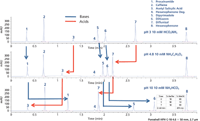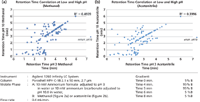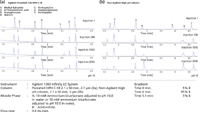Use of Poroshell HPH-C18 Columns at Elevated pH as a Tool for Method Development
The Application Notebook
Agilent Technologies
Optimizing separation of ionizable compounds to find robust conditions has become an important part of method development in liquid chromatography. In this work, adjustment of pH is used to control selectivity using a Poroshell HPH-C18 column that is designed to be stable in high pH mobile phases.
Use of pH to Affect Selectivity
Figure 1 depicts how the elution order of a mixture consisting of acidic, basic, and neutral compound changes as pH of the mobile phase is changed. In this work a generic gradient is used with the organic modifier (acetonitrile) concentration changing from 10% to 90% over 4 min. Chromatograms at pH 3 (ammonium formate), pH 4.8 (ammonium acetate), and pH 10 (ammonium bicarbonate) are shown using mass spec compatible buffers. The flow rate used in this work is 2 mL/min.

Figure 1: Selectivity control by altering pH with an Agilent Poroshell HPH-C18, 4.6 à 50 mm, 2.7-μm LC column at pH 3, 4.8, and 10.
As can be seen, the three chromatograms use the same gradient and column, the neutral (hexanophenone) and non-ionized compounds (caffeine) remain at the same elution time. They are not affected by the change in pH. As the mobile phase pH is increased from pH 4.8 to pH 10, the acidic compounds become charged and their retention time decreases. This is depicted by the red arrows in Figure 2. As the pH is increased the retention time of the bases increases as shown with the blue arrows. The peak elution order changes dramatically as does the spacing. In all three chromatograms the peak shape is excellent. In this case, the spacing of the compounds is more even using the pH 10 buffer than either of the other buffers. In addition to longer retention of bases, better peak shape is also found when using high pH mobile phases as compared to low pH mobile phase.

Figure 2: Retention time correlation with an Agilent Poroshell HPH-C18, pH 3 versus pH 10. (a) methanol, and (b) acetonitrile.
Another way to look at selectivity is by plotting retention time using two different conditions for a group of acids, bases, and neutral compounds. In this case, 117 compounds are run using the Poroshell HPH-C18 column using identical gradients with two organic modifiers (methanol and acetonitrile) and in two pHs (pH 3 and pH 10). The generic gradient used in this work was 0.42 mL/min, starting at 5% organic and increasing to 95% organic over 4 min, and holds at this concentration for 2 min.
As can be seen in Figure 2a, a subgroup of analytes line up perfectly with a slope of 1, these compounds are neutral or non-ionizable compounds with methanol as the organic modifier. These include substituted benzenes, steroids, phenols, and phenones, the retention time of these materials is not affected by the pH of the mobile phase as expected. This methodology was applied and discussed in previous work where two highly similar columns (Poroshell 120 EC-C18 and ZORBAX Eclipse Plus C18) were compared under similar chromatographic conditions (2). Analytes that appear above the line are bases. At pH 3 these compounds are charged, as they become uncharged with the pH increase to 10, the retention time increases. The correlation coefficient of retention times is a measure of the difference of the separation under two different pH conditions. A highly correlated plot would have a value close to 1. This would indicate that the chromatographic separations are very similar. On the other hand, a very low correlation value (close to 0.5 or lower) indicates a more orthogonal or dissimilar separation. A second comparison is also shown in Figure 3b, where a comparison of low and high pH gradients is made using acetonitrile as the organic modifier. In this case the correlation coefficient is smaller than when using methanol (2,3,4).

Figure 3: (a) Excellent retention on the Agilent Poroshell HPH-C18, 2.1 à 50 mm, 2.7-μm column even under high pH bicarbonate conditions (total method run time = 7 min, flow rate 0.4 mL/min). (b) A competitor 3 μm column suffered greater degradation under high pH bicarbonate.
Stability of Poroshell HPH-C18 at High pH
HPLC column stability is one of the critical factors impacting method performance and has been widely studied. Column stability can be affected by temperature, type of aqueous buffer and their concentration, choice of organic solvents, additives, and mobile phase pH. Prescreening of compounds and columns should enable scientists to arrive at successful separations more quickly. HPLC column stability is one of the critical factors affecting method performance. A robust HPLC method using a durable column leads to successful support of new clinical and manufacturing projects. A column that is not stable during method development leads to inaccurate results and frustration.
Column degradation is caused by silica dissolution, bonded-phase removal, or through the exposure of silanols through the removal of end capping (hydrolysis). Both dissolution and hydrolysis of silica columns are known to be related to pH and temperature (increased degradation rate at higher pH/temperatures). Other causes of column degradation include poor sample preparation (dirty samples) and column bed instability.
A good criterion for column stability under a given pH is 500 injections. This allows development, adjustment, and use for a column under an established method. In this work, a Poroshell HPH-C18 column was evaluated in a gradient using ammonium bicarbonate and acetonitrile at pH 10. In this experiment, acidic compounds, neutral compounds, and basic compounds were used. To evaluate columns from a variety of manufacturers, a common stress gradient is used while changing the analytes to accommodate differences in selectivity. In all cases at least two acid, base, and neutral compounds are used.
The impact of sample solution was very minimal, as typically only a few μg of sample were loaded. The test mixture was chosen to assess column performance, not to assess the impact of the test probes themselves on column stability. A low flow rate was used to minimize column bed stability problems during development. As can be seen, the retention time of all compounds remain stable throughout the 2000 injection run with the exception of nortryptyline. This compound, with a pKa very close to the pH of the mobile phase, moves slowly to longer retention times.
A second column from a major competitor is subjected to the same experimental conditions. Most of the analytes remain at the same retention time throughout the 2000 injections. Nortryptyline moves rapidly to later elution times. Within 500 injections, nortryptyline begins to coelute with the next compound, neutral hexanophenone. The peak continues to migrate through this peak, totally coeluting by injection 2000. This experiment indicates greater degradation of the competitor column than Poroshell 120 HPH-C18 column. Differences in peak height occur as the sample is changed.
Conclusion
Using Poroshell HPH C-18, pH can be used to adjust selectivity without sacrificing column lifetime at elevated pH conditions. By keeping a gradient constant and altering pH the elution order of a group eight acid, base, and neutral compounds can be dramatically changed, and in this case chromatographic resolution. In a second experiment, the correlation coefficient of the retention times was determined using a generic gradient plotted for pH 3 and pH 10. Using the R2 as a measure of orthogonality, we find that the two conditions offer different selectivity. Using pH as a method development tool is very effective, especially when the sample contains acidic or basic compounds. We determined that Poroshell HPH-C18 can be used for extended periods (over 2000 injections) at pH 10 in ammonium bicarbonate at 25 °C. By utilizing pH as a method development tool with Poroshell HPH-C18, chromatographers can maximize the flexibility in their method development and analyses, while still benefitting from the rugged, long lifetime with the Poroshell 120 family.
For more details, and to see additional analysis involving LC–MS, download Agilent publication 5991-4893EN.
References
(1) Transfer of Methods between Poroshell 120 EC-C18 and ZORBAX Eclipse Plus C18 Columns, Agilent Technical Report 5990-6580 February 2011.K.
(2) A. Steffens Croes, D. Marchand, and L. Snyder, "Relevance of p–p and Dipole–Dipole Interactions for Retention on Cyano and Phenyl Columns in Reversed-Phase Liquid Chromatography," J. Chromatogr. A 1098(1–2), 123–130 (2005).
(3) W. Long and A. Mack, "Comparison of Selectivity Differences Among Different Agilent ZORBAX Phenyl Columns Using Acetonitrile or Methanol," Agilent Technologies Publication 5990-4711EN, 2009.

Agilent Technologies
2850 Centerville Road, Wilmington, Delaware 19808, USA
Website: www.agilent.com/discoverporoshell

Understanding FDA Recommendations for N-Nitrosamine Impurity Levels
April 17th 2025We spoke with Josh Hoerner, general manager of Purisys, which specializes in a small volume custom synthesis and specialized controlled substance manufacturing, to gain his perspective on FDA’s recommendations for acceptable intake limits for N-nitrosamine impurities.



















